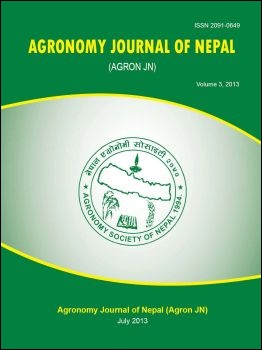Intercropping of chick pea and mustard on control of botrytis grey mold in western Terai, Nepal
DOI:
https://doi.org/10.3126/ajn.v3i0.9010Keywords:
cicer arietinum, Botrytis cinerea, seed ratio, disease severity, AUDPCAbstract
Integrated management strategies are required to minimize botrytis grey mold disease of chickpea (CICER ARIETINUM L.) caused by Botrytis cineria. This study was undertaken to determine the effect of cultivars and seed ratio in chickpea-mustard intercropping system on the severity of botrytis grey mold. Three chickpea varieties Abarodhi, KGP59 and ICCCV 97207 were intercropped with Bikash variety of mustard in different combinations. These two crops were grown at RARS, Khajura in three replications in 2012 at the ratio of sole chickpea, 3.1 ICCV97207.Bikash, 3.1 KPG-59.Bikash, 2.1 KPG59.Bikash, 2.1 ICCV-97207.Bikash,2.2 ICCV97207.Bikash, 2.2 KPG- 59.Bikash,1.2 ICCV97207.Bikash, and 1.2 KPG 59.Bikash. Among the three tested varieties, highest disease score and AUDPC was recorded in Abarodhi (7.00, 0.83), followed by KPG59 (6.444, 0.79), and lowest in ICCV97207 (4.77, 0.58). Similarly in sole cropping, highest yield per plant was found in KPG59 (5.47g), followed by ICCCV9720 (4.46 g) and Abarodhi (3.46 g). Among the tested intercropping system, lowest disease incidence was recorded in 1.2 ICCV97207. Bikas followed by 1.2 KPG59. Bikash. From this research, it can be suggested that intercropping chickpea with mustard can significantly reduce BG of chickpea and thus it could be developed into an environment-friendly cropping system for BG control in chickpea fields. The combination, in which disease incidence was lowest, can be replicated in the areas where BG is a major constraint in chickpea production.
Agronomy Journal of Nepal (Agron JN) Vol. 3. 2013, Page 89-96
Downloads
Downloads
Published
How to Cite
Issue
Section
License
ASON permits for free use, distribution and reproduction in any medium if the original work is properly cited and not used for commercial purposes.




